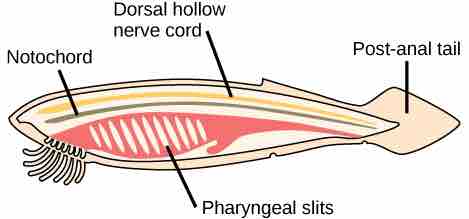Characteristics of Chordata
Animals in the phylum Chordata share four key features that appear at some stage during their development (often, only during embryogenesis) (:

Defining characteristics of chordates
In chordates, four common features appear at some point during development: a notochord, a dorsal hollow nerve cord, pharyngeal slits, and a post-anal tail.
- a notochord
- a dorsal hollow nerve cord
- pharyngeal slits
- post-anal tail
Notochord
The chordates are named for the notochord: a flexible, rod-shaped structure that is found in the embryonic stage of all chordates and also in the adult stage of some chordate species. It is located between the digestive tube and the nerve cord, providing skeletal support through the length of the body. In some chordates, the notochord acts as the primary axial support of the body throughout the animal's lifetime.
In vertebrates, the notochord is present during embryonic development, at which time it induces the development of the neural tube which serves as a support for the developing embryonic body. The notochord, however, is replaced by the vertebral column (spine) in most adult vertebrates.
Dorsal Hollow Nerve Cord
The dorsal hollow nerve cord derives from ectoderm that rolls into a hollow tube during development. In chordates, it is located dorsally (at the top of the animal) to the notochord. In contrast to the chordates, other animal phyla are characterized by solid nerve cords that are located either ventrally or laterally. The nerve cord found in most chordate embryos develops into the brain and spinal cord, which comprise the central nervous system.
Pharyngeal Slits
Pharyngeal slits are openings in the pharynx (the region just posterior to the mouth) that extend to the outside environment. In organisms that live in aquatic environments, pharyngeal slits allow for the exit of water that enters the mouth during feeding. Some invertebrate chordates use the pharyngeal slits to filter food out of the water that enters the mouth. In vertebrate fishes, the pharyngeal slits develop into gill arches, the bony or cartilaginous gill supports.
In most terrestrial animals, including mammals and birds, pharyngeal slits are present only during embryonic development. In these animals, the pharyngeal slits develop into the jaw and inner ear bones.
Post-anal Tail
The post-anal tail is a posterior elongation of the body, extending beyond the anus. The tail contains skeletal elements and muscles, which provide a source of locomotion in aquatic species. In some terrestrial vertebrates, the tail also helps with balance, courting, and signaling when danger is near. In humans and other apes, the post-anal tail is present during embryonic development, but is vestigial as an adult.